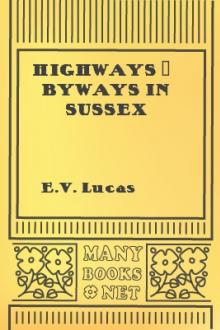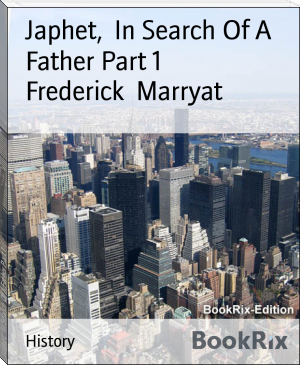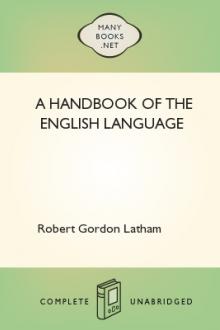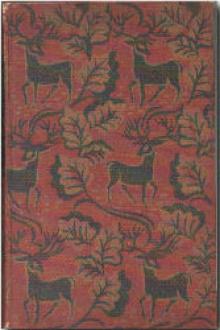Highways & Byways in Sussex by E. V. Lucas (e reader pdf best .txt) 📕

- Author: E. V. Lucas
- Performer: -
Book online «Highways & Byways in Sussex by E. V. Lucas (e reader pdf best .txt) 📕». Author E. V. Lucas
"At Brightelmstone:—washed in ye sea."
CHAPTER XXII CUCKFIELDHayward's Heath—Rookwood and the fatal tree—Timothy Burrell and his account books—Old Sussex appetites—Plum-porridge—A luckless lover—The original Merry Andrew—Ancient testators—Bolney's bells—The splendour of the Slaugham Coverts—Hand Cross—Crawley and the new discovery of walking—Lindfield—Idlehurst—Richard Turner's epitaph—Ardingly.
Hayward's Heath, on the London line, would be our next centre were it not so new and suburban. Fortunately Cuckfield, which has two coaching inns and many of the signs of the leisurely past, is close by, in the midst of very interesting country, with a church standing high on the ridge to the south of the town, broadside to the Weald, its spire a landmark for miles. Cuckfield Place (a house and park, according to Shelley, which abounded in "bits of Mrs. Radcliffe") is described in Harrison Ainsworth's Rookwood. It was in the avenue leading from the gates to the house that that fatal tree stood, a limb of which fell as the presage of the death of a member of the family. So runs the legend. Knowledge of the tree is, however, disclaimed by the gatekeeper.
Cuckfield Church
Cuckfield Church.Ockenden House, in Cuckfield, has been for many years in the possession of the Burrell family, one of whom, Timothy Burrell, an ancestor of the antiquary, left some interesting account books, which contain in addition to figures many curious and sardonic entries and some ingenious hieroglyphics. I quote here and there, from the Sussex Archæological Society's extracts, by way of illustrating the life of a Sussex squire in those days, 1683-1714:—
1705. "Pay'd Gosmark for making cyder 1 day, whilst John Coachman was to be drunk with the carrier's money, by agreement; and I pay'd 2d. to the glasyer for mending John's casement broken at night by him when he was drunk.
"1706. 25th March. Pd. John Coachman by Ned Virgo, that he may be drunk all the Easter week, in part of his wages due, £1."
This was the fare provided on January 1, 1707, for thirteen guests:—
Plum porridge, it may interest some to know, was made thus: "Take of beef-soup made of legs of beef, 12 quarts; if you wish it to be particularly good, add a couple of tongues to be boiled therein. Put fine bread, sliced, soaked, and crumbled; raisins of the sun, currants and pruants two lbs. of each; lemons, nutmegs, mace and cloves are to be boiled with it in a muslin bag; add a quart of red wine and let this be followed, after half an hour's boiling, by a pint of sack. Put it into a cool place and it will keep through Christmas."
Mr. Burrell giving a small dinner to four friends, offered them
Pease pottage.
2 carps. 2 tench. Roast leg of mutton. Capon. Pullet. Apple pudding. Fried oysters. Goos. Baked pudding. Tarts. Minced pies.It is perhaps not surprising that the host had occasionally to take the waters of Ditchling, which are no longer drunk medicinally, or to dose himself with hieræ picræ.
One more dinner, this time for four guests, who presumably were more worthy of attention:—
A soup take off.
Two large carps at the upper end.
Pidgeon pie, salad, veal ollaves,
Leg of mutton, and cutlets at the lower end.
Three rosed chickens.
Scotch pancakes, tarts, asparagus.
Three green gees at the lower end.
In the room of the chickens removed,
Four-souced Mackerel.
Rasins in cream at the upper end.
Calves' foot jelly, dried sweetmeats, calves' foot jelly.
Flummery, Savoy cakes.
Imperial cream at the lower end.
In October, 1709, Mr. Burrell writes in Latin: "From this time I have resolved, as long as the dearth of provisions continues, to give to the poor who apply for it at the door on Sundays, twelve pounds of beef every week, on the 11th of February 4lbs. more, in all 16lbs., and a bushel of wheat and half a bushel of barley in 4 weeks."
From Borde Hill to the north-east of Cuckfield, is supposed to have come Andrew Boord, the original Merry Andrew. Among the later Boords who lived there was George Boord, in whose copy of Natura Brevium and Tenores Novelli, bound together (given him by John Sackville of Chiddingly Park) is written:—
which Mr. Lower translates:
This Boord would be a relative of the famous Andrew, priest, doctor and satirist (1490-1549) who may indeed have been the author of the distich above. It is certainly in his vein.
Andrew Boord gave up his vows as a Carthusian on account of their "rugorosite," and became a doctor, travelling much on the Continent. Several books are known to be his, chief among them the Dyetary and Brevyary of Health. He wrote also an Itinerary of England and is credited by some with the Merrie Tales of the Mad Men of Gotham. Lower and Horsfield indeed hold that the Gotham intended was not the Nottinghamshire village but Gotham near Pevensey, where Boord had property. That he knew something of Sussex is shown by Boord's Boke of Knowledge, where he mentions the old story, then a new one, that no nightingale will sing in St. Leonard's Forest. It is the Boke of Knowledge that has for frontispiece the picture of a naked Englishman with a pair of shears in one hand and a piece of cloth over the other arm, saying:
We shall see Andrew again when we come to Pevensey.
A glimpse of the orderly mind of a pre-Reformation Cuckfield yeoman is given in a will quoted recently in the Sussex Daily News, in an interesting series of articles on the county under the title of "Old-time Sussex":
"In the yere of our lorde god 1545. the 26 day of June, I, Thomas Gaston, of the pish of Cukefelde, syke in body, hole, and of ppt [perfect] memorie, ordene and make this my last will and test, in manr. and forme folling.
Fyrst I bequethe my sowle to Almyghty god or [our] lady St. Mary and all the holy company of heyvyng, my bodie to be buried in the church yarde of Cukefeld.
It. (item) to the Mother Church of Chichester 4d.
It. to the hye alter of Cuckfeld 4d.
It. I will have at my buryall 5 masses. In lykewise at my monthes mynd and also at my yerely mynd all the charge of the church set apart I will have in meate and drynke and to pore people 10s. at every tyme."
The high altar was frequently mentioned favourably in these old wills. Another Cuckfield testator, in 1539, left to the high altar, "for tythes and oblacions negligently forgotten, sixpence." The same student of the Calendar of Sussex Wills in the District Probate Registry at Lewes, between 1541 and 1652, which the British Record Society have just published, copies the following passage from the will of Gerard Onstye, in 1568: "To mary my daughter £20, the ffeatherbed that I lye upon the bolsters and coverlete of tapestaye work with a blankett, 4 payres of shetts that is to say four pares of the best flaxon and other 2 payre of the best hempen the greate brasse potte that hir mother brought, the best bord-clothe (table cloth?) a lynnen whelle (i.e., spinning-wheel) that was hir mothers, the chaffing dish that hangeth in the parlor."
In those simple days everything was prized. In one of these Sussex wills, in 1594, Richard Phearndeane, a labourer, left to his brother Stephen his best dublett, his best jerkin and his best shoes, and to Bernard Rosse his white dublett, his leathern dublett and his worst breeches.
Three miles west of Cuckfield is Bolney, just off the London road, a village in the southern boundary of St. Leonard's Forest, the key to some very rich country. Before the days of bicycles Bolney was practically unknown, so retired is it. The church, which has a curious pinnacled tower nearly 300 years old, is famous for its bells, concerning whose melody Horsfield gives the following piece of counsel: "Those who are fond of the silvery tones of bells, may enjoy them to perfection, by placing themselves on the margin of a large pond, the property of Mr. W. Marshall; the reverberation of the sound, coming off the water, is peculiarly striking."
Sixty years ago this sheet of water had an additional attraction. Says Mr. Knox, "During the months of May and June, 1843, an osprey was observed to haunt the large ponds near Bolney. After securing a fish he used to retire to an old tree on the more exposed bank to devour it, and about the close of evening was in the habit of flying off towards the north-west, sometimes carrying away a prize in his talons if his sport had been unusually successful, as if he dreaded being disturbed at his repast during the dangerous hours of twilight. Having been shot at several times without effect, his visits to these ponds became gradually less frequent, but the surrounding covers being unpreserved, and the bird itself too wary to suffer a near approach, he escaped the fate of many of his congeners, and even re-appeared with a companion early in the following September, to whom he seemed to have imparted his salutary dread of man—his mortal enemy—for during the short time they remained there it was impossible to approach within gunshot of either of them."
The indirect road from Bolney to Hand Cross, through Warninglid and Slaugham (parallel with the coaching road), is superb, taking us again into the iron country and very near to Leonardslee, which we have already seen.
The glory of Slaugham Place is no more; but one visible sign of it is preserved in Lewes, in the Town Hall, in the shape of its old staircase. Slaugham Place was the seat of the Covert family, whose estates extended, says tradition, "from Southwark to the Sea," and, says the more exact Horsfield, from Crawley to Hangleton, above Brighton. Slaugham Park used to cover 1200 acres, the church being within it. Perhaps nowhere in Sussex is the change so complete as here, and within recent times too, for Horsfield quotes, in 1835, the testimony of "an aged person, whom the present rector buried about twenty-five years back, who used to relate, that he remembered when the family at Slaugham Park, or Place, consisted of seventy persons." Horsfield continues, in a footnote (the natural receptacle of many of his most interesting statements):—"The name of the aged person alluded to was Harding, who died at nearly 100. According to his statement, the family were so numerous, they kept constantly employed mechanics of every description, who resided on the premises. A conduit, which supplied the mansion with water, is now used by the inhabitants of the village. The kitchen fireplace still remains, of immense size, with the irons that supported the cooking apparatus. The arms of the Coverts, with many impalements and quarterings, yet remain on the ruins. The principal entrance was from the east, and the grand front to the north. The pillars at the entrance, fluted, with seats on each side, are still there. According to the statement of the above person, there was a chapel attached to the





Comments (0)